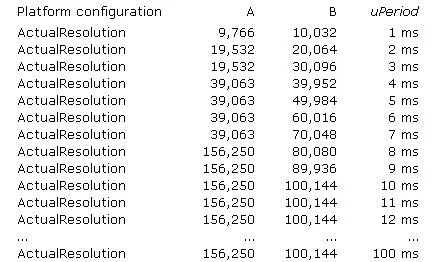基于其他解决方案和评论,我编写了这段VB.NET代码。可以将其粘贴到带有表单的项目中。我理解@HansPassant的评论是说只要调用timeBeginPeriod,“常规计时器也会变得准确”。但在我的代码中似乎并非如此。
我的代码创建了一个多媒体定时器、一个System.Threading.Timer、一个System.Timers.Timer和一个Windows.Forms.Timer,然后使用timeBeginPeriod将定时器分辨率设置为最小值。多媒体定时器按照所需的1 kHz运行,但其他定时器仍然停留在64 Hz。所以要么我做错了什么,要么就没有办法改变内置的.NET定时器的分辨率。
编辑:更改了代码以使用StopWatch类进行计时。
Imports System.Runtime.InteropServices
Public Class Form1
'From http://www.pinvoke.net/default.aspx/winmm/MMRESULT.html
Private Enum MMRESULT
MMSYSERR_NOERROR = 0
MMSYSERR_ERROR = 1
MMSYSERR_BADDEVICEID = 2
MMSYSERR_NOTENABLED = 3
MMSYSERR_ALLOCATED = 4
MMSYSERR_INVALHANDLE = 5
MMSYSERR_NODRIVER = 6
MMSYSERR_NOMEM = 7
MMSYSERR_NOTSUPPORTED = 8
MMSYSERR_BADERRNUM = 9
MMSYSERR_INVALFLAG = 10
MMSYSERR_INVALPARAM = 11
MMSYSERR_HANDLEBUSY = 12
MMSYSERR_INVALIDALIAS = 13
MMSYSERR_BADDB = 14
MMSYSERR_KEYNOTFOUND = 15
MMSYSERR_READERROR = 16
MMSYSERR_WRITEERROR = 17
MMSYSERR_DELETEERROR = 18
MMSYSERR_VALNOTFOUND = 19
MMSYSERR_NODRIVERCB = 20
WAVERR_BADFORMAT = 32
WAVERR_STILLPLAYING = 33
WAVERR_UNPREPARED = 34
End Enum
'http://msdn.microsoft.com/en-us/library/windows/desktop/dd757625(v=vs.85).aspx
<StructLayout(LayoutKind.Sequential)>
Public Structure TIMECAPS
Public periodMin As UInteger
Public periodMax As UInteger
End Structure
'http://msdn.microsoft.com/en-us/library/windows/desktop/dd757627(v=vs.85).aspx
<DllImport("winmm.dll")>
Private Shared Function timeGetDevCaps(ByRef ptc As TIMECAPS, ByVal cbtc As UInteger) As MMRESULT
End Function
'http://msdn.microsoft.com/en-us/library/windows/desktop/dd757624(v=vs.85).aspx
<DllImport("winmm.dll")>
Private Shared Function timeBeginPeriod(ByVal uPeriod As UInteger) As MMRESULT
End Function
'http://msdn.microsoft.com/en-us/library/windows/desktop/dd757626(v=vs.85).aspx
<DllImport("winmm.dll")>
Private Shared Function timeEndPeriod(ByVal uPeriod As UInteger) As MMRESULT
End Function
'http://msdn.microsoft.com/en-us/library/windows/desktop/ff728861(v=vs.85).aspx
Private Delegate Sub TIMECALLBACK(ByVal uTimerID As UInteger, _
ByVal uMsg As UInteger, _
ByVal dwUser As IntPtr, _
ByVal dw1 As IntPtr, _
ByVal dw2 As IntPtr)
'Straight from C:\Program Files (x86)\Microsoft SDKs\Windows\v7.1A\Include\MMSystem.h
'fuEvent below is a combination of these flags.
Private Const TIME_ONESHOT As UInteger = 0
Private Const TIME_PERIODIC As UInteger = 1
Private Const TIME_CALLBACK_FUNCTION As UInteger = 0
Private Const TIME_CALLBACK_EVENT_SET As UInteger = &H10
Private Const TIME_CALLBACK_EVENT_PULSE As UInteger = &H20
Private Const TIME_KILL_SYNCHRONOUS As UInteger = &H100
'http://msdn.microsoft.com/en-us/library/windows/desktop/dd757634(v=vs.85).aspx
'Documentation is self-contradicting. The return value is Uinteger, I'm guessing.
'"Returns an identifier for the timer event if successful or an error otherwise.
'This function returns NULL if it fails and the timer event was not created."
<DllImport("winmm.dll")>
Private Shared Function timeSetEvent(ByVal uDelay As UInteger, _
ByVal uResolution As UInteger, _
ByVal TimeProc As TIMECALLBACK, _
ByVal dwUser As IntPtr, _
ByVal fuEvent As UInteger) As UInteger
End Function
'http://msdn.microsoft.com/en-us/library/windows/desktop/dd757630(v=vs.85).aspx
<DllImport("winmm.dll")>
Private Shared Function timeKillEvent(ByVal uTimerID As UInteger) As MMRESULT
End Function
Private lblRate As New Windows.Forms.Label
Private WithEvents tmrUI As New Windows.Forms.Timer
Private WithEvents tmrWorkThreading As New System.Threading.Timer(AddressOf TimerTick)
Private WithEvents tmrWorkTimers As New System.Timers.Timer
Private WithEvents tmrWorkForm As New Windows.Forms.Timer
Public Sub New()
lblRate.AutoSize = True
Me.Controls.Add(lblRate)
InitializeComponent()
End Sub
Private Capability As New TIMECAPS
Private Sub Form1_FormClosing(sender As Object, e As System.Windows.Forms.FormClosingEventArgs) Handles Me.FormClosing
timeKillEvent(dwUser)
timeEndPeriod(Capability.periodMin)
End Sub
Private dwUser As UInteger = 0
Private Clock As New System.Diagnostics.Stopwatch
Private Sub Form1_Load(sender As System.Object, e As System.EventArgs) _
Handles MyBase.Load
Dim Result As MMRESULT
'Get the min and max period
Result = timeGetDevCaps(Capability, Marshal.SizeOf(Capability))
If Result <> MMRESULT.MMSYSERR_NOERROR Then
MsgBox("timeGetDevCaps returned " + Result.ToString)
Exit Sub
End If
'Set to the minimum period.
Result = timeBeginPeriod(Capability.periodMin)
If Result <> MMRESULT.MMSYSERR_NOERROR Then
MsgBox("timeBeginPeriod returned " + Result.ToString)
Exit Sub
End If
Clock.Start()
Dim uTimerID As UInteger
uTimerID = timeSetEvent(Capability.periodMin, Capability.periodMin, _
New TIMECALLBACK(AddressOf MMCallBack), dwUser, _
TIME_PERIODIC Or TIME_CALLBACK_FUNCTION Or TIME_KILL_SYNCHRONOUS)
If uTimerID = 0 Then
MsgBox("timeSetEvent not successful.")
Exit Sub
End If
tmrWorkThreading.Change(0, 1)
tmrWorkTimers.Interval = 1
tmrWorkTimers.Enabled = True
tmrWorkForm.Interval = 1
tmrWorkForm.Enabled = True
tmrUI.Interval = 100
tmrUI.Enabled = True
End Sub
Private CounterThreading As Integer = 0
Private CounterTimers As Integer = 0
Private CounterForms As Integer = 0
Private CounterMM As Integer = 0
Private ReadOnly TimersLock As New Object
Private Sub tmrWorkTimers_Elapsed(sender As Object, e As System.Timers.ElapsedEventArgs) _
Handles tmrWorkTimers.Elapsed
SyncLock TimersLock
CounterTimers += 1
End SyncLock
End Sub
Private ReadOnly ThreadingLock As New Object
Private Sub TimerTick()
SyncLock ThreadingLock
CounterThreading += 1
End SyncLock
End Sub
Private ReadOnly MMLock As New Object
Private Sub MMCallBack(ByVal uTimerID As UInteger, _
ByVal uMsg As UInteger, _
ByVal dwUser As IntPtr, _
ByVal dw1 As IntPtr, _
ByVal dw2 As IntPtr)
SyncLock MMLock
CounterMM += 1
End SyncLock
End Sub
Private ReadOnly FormLock As New Object
Private Sub tmrWorkForm_Tick(sender As Object, e As System.EventArgs) Handles tmrWorkForm.Tick
SyncLock FormLock
CounterForms += 1
End SyncLock
End Sub
Private Sub tmrUI_Tick(sender As Object, e As System.EventArgs) _
Handles tmrUI.Tick
Dim Secs As Integer = Clock.Elapsed.TotalSeconds
If Secs > 0 Then
Dim TheText As String = ""
TheText += "System.Threading.Timer " + (CounterThreading / Secs).ToString("#,##0.0") + "Hz" + vbCrLf
TheText += "System.Timers.Timer " + (CounterTimers / Secs).ToString("#,##0.0") + "Hz" + vbCrLf
TheText += "Windows.Forms.Timer " + (CounterForms / Secs).ToString("#,##0.0") + "Hz" + vbCrLf
TheText += "Multimedia Timer " + (CounterMM / Secs).ToString("#,##0.0") + "Hz"
lblRate.Text = TheText
End If
End Sub
End Class
 可以很容易地看出1毫秒是一个理论值。ActualResolution以100纳秒为单位给出。9,766表示0.9766毫秒,即每秒1024个中断。(实际上应该是0.9765625,这将是97656.25 100纳秒单位,但这种准确性显然不能适应整数,因此被系统四舍五入。)
可以很容易地看出1毫秒是一个理论值。ActualResolution以100纳秒为单位给出。9,766表示0.9766毫秒,即每秒1024个中断。(实际上应该是0.9765625,这将是97656.25 100纳秒单位,但这种准确性显然不能适应整数,因此被系统四舍五入。)
System.Threading.Timer看看是否可行。 - SerdalisSystem.Timers.Timer,System.Threading.Timer和Windows.Forms.Timer;请参见此问题。 - darda